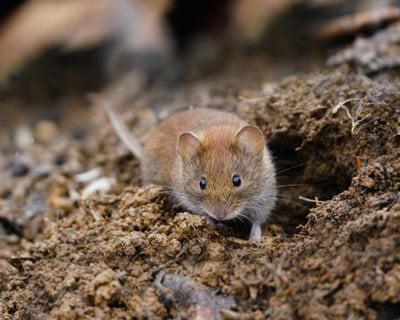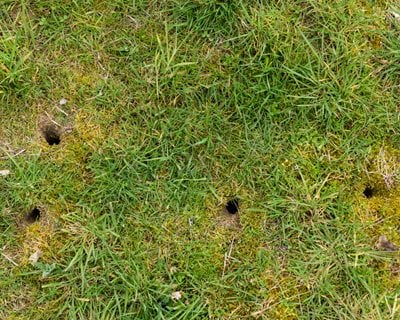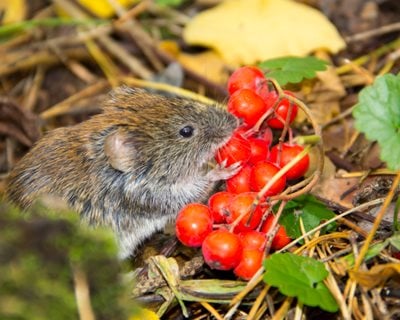How to Get Rid of Voles in Your Garden
Use safe and effective methods to control these pests
Photo by: Monika Surzin / Shutterstock.
Dealing with pests can be one of the most trying aspects of gardening. Whether it’s insects or animals, it seems like there’s always something disturbing our plants. Voles are one of those creatures that can wreak havoc if not properly identified and controlled. Voles cause damage to lawns, gardens, golf courses, crops, orchards, and young trees. Damage can be severe when populations surge.
There are many different ways to deal with voles. Effectiveness depends on many factors, including property size, type of method, vole population, time of year, and weather. Here are some suggestions:
On this page: 5 Ways to Get Rid of Voles | Methods to Avoid | Precautions | Vole Damage: Identify, Repair, Prevent | Voles 101
On this page:
- 5 WAYS TO GET RID OF VOLES
- METHODS TO AVOID
- PRECAUTIONS
- VOLE DAMAGE: IDENTIFY, REPAIR, PREVENT
- VOLES 101
5 WAYS TO GET RID OF VOLES
BARRIERS
Most vole species are poor climbers, so physical barriers can be an effective way of keeping them from damaging plants.
Tree guards: Protect young trees with a metal, wire mesh, or plastic guard around the lower trunk. Bury the bottom of the barrier 6 inches below the soil surface so voles can’t burrow underneath. Make sure the guard doesn’t constrict the trunk. Check periodically to make sure voles haven’t made their way in and are hiding inside the guard.
Fencing: Protect vegetable plots or other garden areas with a wire fence around the perimeter. Mesh size should be 1/4 inch or less. Make sure the fence extends at least 12 inches above the ground, with the bottom edge buried 6 to 10 inches below the soil surface to prevent voles from digging underneath.
Gravel: Gravel makes an effective barrier, as voles don’t like to dig through a layer of small rocks. Mix coarse gravel into flower beds or create a moat of gravel around beds to keep voles out. When planting bulbs, add gravel to the planting hole.
- PLANTS
Plants voles won’t eat: While voles will feed on most plants, there are a few they find distasteful. These include crown imperial (Fritillaria imperialis), daffodils, grape hyacinth, hellebores, iris, salvia, and snowdrops.
Plants that repel voles: Voles will avoid most plants in the allium family. Plant ornamental alliums in garden beds and include garlic, onions, and chives in edible plots to deter voles.
- PREDATORY ANIMALS
Provide habitat to encourage natural predators such as snakes, owls, hawks, and foxes.
- REPELLENT PRODUCTS
Repellents are designed to make the environment and food sources of voles inhospitable so they will move elsewhere.
Natural repellents: These come in liquid or granular form and may contain a variety of ingredients that voles find distasteful, including castor oil, citronella, mint, cedar, thyme, garlic, or pepper. Spread around areas where voles are present according to instructions.
Homemade repellents: Make your own homemade repellent with ingredients such as garlic, onion, crushed mint leaves, cayenne powder, or chili pepper. Mix with water or soap and water. Apply with a sprayer, repeating after it rains.
- LIVE TRAPS
Traps can be effective if populations are small or are confined to a limited area. Using a larger number of traps rather than one or a few will yield better results. Place humane traps along vole runways or burrow entrances, using peanut butter as bait. Check traps daily. Relocate voles if allowed in your area.
When should you call a professional? If you’re in need of a quick solution, have a large area to treat, or are heavily infested, you may want to call in a professional. Once they’ve come in and gained the upper hand, you may be able to take over and maintain control.
VOLE CONTROL METHODS TO AVOID
POISONS
Chemical poisons and baits should never be used to control pests of any kind, as they are often ingested by pets and beneficial wildlife. Poisonous pest controls pose a major threat to birds of prey such as eagles, hawks, and owls, as well as many wild mammals as they can become secondarily poisoned by eating an animal that has ingested the poison.
OTHER
Remedies such as fumigants, flooding, electromagnetic or ultrasonic devices may be less effective or ineffective at controlling voles.
PRECAUTIONS
Voles seldom come into direct contact with humans, but can carry diseases such as rabies, hantavirus, plague, salmonella, tularemia, and tick-borne illnesses such as Lyme’s disease, Rocky Mountain spotted fever, and babesiosis. When working around areas that voles frequent, make sure to wear close-toed shoes and rubber gloves to avoid possible contact with vole urine and feces.

Photo by: Dietrich Leppert / Shutterstock.
VOLE DAMAGE: IDENTIFY, REPAIR, PREVENT
HOW TO IDENTIFY VOLE DAMAGE
Voles create an extensive network of shallow underground tunnels 2 inches wide. The most visible indication of their presence is the above-ground burrow openings that are connected by well-used runways, which may be partially obscured by grass or groundcovers.
Voles damage plants above and below ground, eating roots and bulbs when they tunnel and consuming plant stems and leaves when above ground. Dead patches in lawn areas are created where voles create runways and feed on grass.
Look for signs including droppings, fresh trails with clipped or trampled grass, and plants that suddenly wilt or die. There may be gnaw marks on garden plants, vegetables, and around the base of trees and shrubs. Extensive tree root damage can cause dieback of the crown and leaning.
These destructive rodents stay active throughout winter, eating plant roots, bulbs and bark while snow cover hides their activities. Winter damage may not be fully evident until spring when the snow melts and voles become more active.
HOW TO REPAIR VOLE DAMAGE
Damage is usually most severe in spring when voles are most active. In many cases, plants will recover on their own once the vole population is under control. Destroy runways and burrows with a shovel or rototiller to discourage new voles from moving in. Rake up dead grass and replant bare areas with grass seed to restore lawn areas where runways are present.
HOW TO PREVENT VOLE DAMAGE
One of the best ways to discourage voles is to make your yard less inviting. Voles need cover to survive and will avoid open areas. They prefer heavy vegetation, as it provides protection from predators.
Keep it neat: Prune shrubs, control weeds, rake leaves and keep lawns mowed. Create buffers around garden areas that are free of debris.
Protect trees: Clear areas around young trees and avoid dense mulching to discourage voles from nibbling the bark around the base. A 4-foot buffer is usually sufficient, as voles don’t like to feed out in the open. For fruiting trees, pick up any fallen fruit.
Clean it up: Keep areas underneath bird feeders clean to discourage voles and other vermin.
VOLES 101
WHAT IS A VOLE?
Commonly referred to as meadow or field mice, voles are rodents that are related to hamsters and lemmings. They have a mouse-like appearance, with a stocky build, rounded ears, and dense fur that is brown, grey or black. Adults can reach 5 to 8 inches long, including the tail.
Voles can breed at any time of year, with peak breeding in spring and summer. They reproduce quickly which can add up to a large vole infestation in a short amount of time. The average lifespan of a vole is 6 months to a year.
WHERE DO VOLES LIVE?
Voles prefer open grassy areas and fields, but can also venture into residential yards. Voles will seldom go inside homes. The presence of voles is more likely in suburbs or properties that border natural areas than in urban settings. Voles burrow tunnels just beneath the soil surface where they eat and nest, but they spend time above ground as well. They are present in most regions and are active year-round.

Photo by: S. Zykov / Shutterstock.
WHAT DO VOLES EAT?
Primarily herbivores, the preferred food of voles is the stems and blades of grass. They will also eat roots, bulbs, and tubers, feasting on the bark and roots of trees and shrubs primarily in fall and winter when other food is more scarce. Other food sources may include insects, dead animals, vegetables, fruits, seeds, and nuts.
VOLE VS MOLE?
These two garden pests are often confused for their similar name and tunneling behavior. Since both are rarely seen, they can best be distinguished from each other by the telltale signs they leave behind. Moles create deeper tunnels with shallow mounds at the surface, while voles leave no mounds behind.
Moles are insectivore mammals, eating primarily earthworms, grubs, and insects, while voles are herbivore rodents. Moles have a long snout, tiny eyes and ears and paddle-like forefeet designed for digging, while voles more closely resemble mice.
VOLE VS MOUSE?
Mice have larger ears and eyes, and their snouts are more pointed. Voles have a compact build, while mice are more slender. Mice have tails that extend nearly as long as their body, while voles have shorter tails.
RELATED:
How to Get Rid of Squirrels
Rabbits - Natural Ways to Protect Your Garden
How to Get Rid of Gophers
